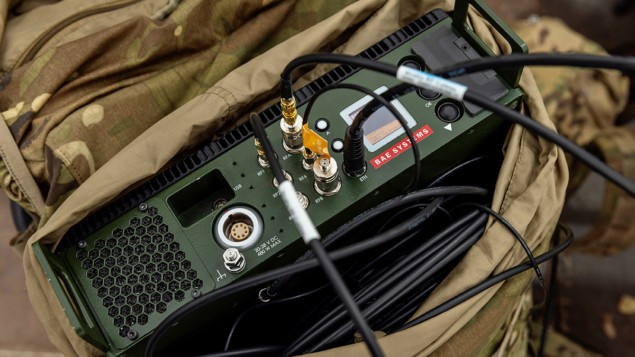BAE Systems Digital Intelligence offers early-career physicists the opportunity to deliver game-changing technology innovations within its Wireless Products team

Lancaster University physics graduate Ben is a member of the Wireless Products team at BAE Systems Digital Intelligence, a company that employs more than 4500 digital, cyber and intelligence experts to help government, military and commercial customers defend against advanced threats. He talked to Physics World about the joys of working at the cutting edge in electronics and digital signal processing while applying his mathematics and physics skills to diverse engineering problems.
What’s it like to work in the Wireless Products team?
On my first day in the office, I vividly remember being so happy to see colleagues writing equations, drawing diagrams and elaborating elegant technical explanations on whiteboards – reminiscent of working in the library meeting rooms at Lancaster during my physics degree. Overhearing staff discussing their R&D projects meant learning about exciting scientific and engineering concepts of which I knew very little – plus, like my colleagues, I still try to find any excuse to work things out on a whiteboard.
By extension, I couldn’t wait to start using complex mathematical and physical models for concrete applications. Many aspects of our engineering work involve experimentation, preparing for a complex future regarding national security, law enforcement and military defence. In other cases, problem-solving is the key to realizing digital solutions for emerging real-world problems and threats.
Why should a talented physics graduate consider the Wireless Products team as a potential career pathway?

Working at the cutting edge is not something you can get just anywhere. Yet that’s exactly what we do day in, day out here at BAE Systems Digital Intelligence, delivering innovative next-generation technologies for our customers. I love the whole creative process that’s needed to realize a technical and commercial outcome. Put another way: you spend the bulk of your time coming up with new ideas, theories and clever solutions to address thorny science and engineering problems, applying all the physics domain knowledge you’ve learned along the way, and then you’re able to see your efforts take shape as an end-product in front of your eyes.
Another unique feature is the multidisciplinary nature of our programme. As such, there’s the opportunity to delve deep into one field – digital signal processing (DSP), for example, or radio-frequency propagation. Equally, we are encouraged to indulge our curiosity and become well-rounded scientists and engineers, at ease with the ambiguity that comes when working across a range of specialisms. That multidisciplinary mindset is a real differentiator and provides a solid basis for fast-track learning and development through your career.
What sort of R&D projects do you get to work on?
The high-level goal within the team is to use DSP to manipulate the electromagnetic world around us – and with a core emphasis on advanced software-defined radio (SDR) technologies. A case study in this regard is the Army Warfighting Experiment (AWE), where I was part of a cross-functional engineering team tasked with integrating three mission-critical applications into a multipurpose SDR platform.
The DSP was a stand-out feature of this R&D effort. We reworked intricate mathematics and implemented it onto a chip called a field-programmable gate array (FPGA) – essentially the crossover between hardware and software. Using this in conjunction with our DSP knowledge, we can manipulate the electromagnetic wave’s physical properties – such as its frequency, time characteristics and phase – to pull out information in innovative ways. On top of this are many layers of complex hardware, firmware and software such that when a user tells the radio to do something different to what it is currently doing, the radio will accomplish this task. It’s incredible how proud and excited the team felt when demonstrating the finished product for end-users.
What can early-career scientists expect in terms of training and development?
On reflection, one of the best aspects of the Wireless Products team is the fact that you are working in a department full of subject-matter experts across diverse fields of science and engineering. Even better, they are all willing to get stuck in to help anyone out. This on-demand support network is the best training you could wish for as an early-career physicist, creating the opportunity to broaden your knowledge base and become an established and reputable member of the team.
How about long-term career progression?
The Wireless Products team is a relatively young group of people – something that surprised me when I first got here. Even so, there’s a can-do culture with a lot of talented scientists and engineers who are more than ready – and willing – to take on leadership roles after just a couple of years in their roles. They want to be the best of the best and they’re encouraged in that regard by their colleagues and senior management.
That’s certainly my objective: to start leading development projects in the near- to medium term while working to become a “sphere of influence” – in other words, a domain expert in a technical niche where I can establish myself as the go-to expert within the company, even across the country. Overall, I can say that I am in the perfect place to constantly learn, to be challenged, to contribute as an individual as well as part of the collective – and framed within our ultimate objective of keeping people and society safe from harm. Bring on the next challenge!
Applying physics to counter complex threats
The Wireless Products team within BAE Systems Digital Intelligence applies its cutting-edge capability in electronics and DSP to a range of complex challenges. These include:
- Software radio and applications: developing and manufacturing high-performance software-defined radio hardware and software for applications in national security, law enforcement and military systems.
- Surveillance technology: developing comprehensive end-to-end solutions for use in demanding operational security and environmental conditions.
- Situational awareness: providing sensors and dedicated instrumentation to both capture and make sense of the acoustic or electromagnetic environment.
- Advanced signal processing: interrogating complex, high-bandwidth data streams in real-time through the use of embedded DSP on FPGAs and software (e.g. C/C++/Java).
- Specialist communications: delivering critical systems to enable military forces to communicate securely even in difficult electromagnetic environments – from submarines under the oceans through to geostationary satellites in space.
- SEO Powered Content & PR Distribution. Get Amplified Today.
- PlatoData.Network Vertical Generative Ai. Empower Yourself. Access Here.
- PlatoAiStream. Web3 Intelligence. Knowledge Amplified. Access Here.
- PlatoESG. Carbon, CleanTech, Energy, Environment, Solar, Waste Management. Access Here.
- PlatoHealth. Biotech and Clinical Trials Intelligence. Access Here.
- Source: https://physicsworld.com/a/multidisciplinary-collaboration-opens-the-way-to-strategic-innovation-in-wireless-technology/
- :is
- :not
- :where
- $UP
- a
- Able
- About
- accomplish
- across
- address
- advanced
- After
- against
- All
- along
- am
- Ambiguity
- an
- and
- Another
- any
- anyone
- anywhere
- applications
- applies
- Applying
- ARE
- Army
- around
- Array
- AS
- aspects
- At
- base
- basis
- BE
- become
- being
- ben
- BEST
- Better
- between
- both
- bring
- broaden
- by
- called
- CAN
- Can Get
- capability
- capture
- Career
- case
- case study
- cases
- certainly
- challenged
- challenges
- characteristics
- chip
- click
- collaboration
- colleagues
- Collective
- comes
- coming
- commercial
- communicate
- company
- complex
- comprehensive
- concepts
- conditions
- conjunction
- Consider
- constantly
- contribute
- Core
- could
- Counter
- country
- Couple
- Creating
- Creative
- critical
- Culture
- curiosity
- Currently
- Customers
- cutting
- cutting-edge
- cyber
- data
- day
- dedicated
- deep
- defence
- Degree
- deliver
- delivering
- delve
- demanding
- demonstrating
- Department
- developing
- Development
- diagrams
- different
- differentiator
- difficult
- digital
- discussing
- diverse
- do
- doing
- domain
- drawing
- during
- e
- ease
- Edge
- effort
- efforts
- Electronics
- embedded
- emerging
- emphasis
- employs
- enable
- encouraged
- end-to-end
- enforcement
- Engineering
- Engineers
- Environment
- environmental
- environments
- equally
- equations
- equipment
- essentially
- establish
- established
- Even
- exactly
- example
- excited
- exciting
- expect
- expert
- experts
- extension
- Eyes
- fact
- Feature
- felt
- field
- Fields
- Find
- First
- For
- Forces
- fpga
- Frequency
- from
- front
- full
- future
- get
- goal
- got
- Government
- graduate
- Group
- happy
- Hardware
- harm
- he
- help
- here
- high-level
- high-performance
- his
- How
- HTTPS
- i
- ideas
- image
- implemented
- in
- In other
- include
- incredible
- individual
- information
- Innovation
- innovations
- innovative
- Integrating
- Intelligence
- into
- involve
- issue
- IT
- ITS
- joys
- jpg
- just
- keeping
- Key
- knowledge
- Law
- law enforcement
- layers
- Leadership
- leading
- LEARN
- learned
- learning
- Library
- like
- little
- long-term
- Lot
- love
- make
- management
- manufacturing
- many
- mathematical
- mathematics
- max-width
- me
- meant
- medium
- meeting
- member
- Military
- Mindset
- models
- more
- multidisciplinary
- my
- myself
- National
- national security
- Nature
- needed
- network
- New
- next
- next-generation
- niche
- objective
- of
- Offers
- Office
- on
- on leadership
- On-Demand
- ONE
- onto
- open
- opens
- operational
- Opportunity
- or
- Other
- our
- out
- Outcome
- overall
- part
- pathway
- People
- perfect
- perfect place
- phase
- physical
- Physics
- Physics World
- Place
- platform
- plato
- Plato Data Intelligence
- PlatoData
- plus
- potential
- preparing
- problem-solving
- problems
- process
- processing
- Product
- Products
- programme
- progression
- projects
- properties
- proud
- provides
- providing
- put
- R&D
- Radio
- range
- ready
- real
- real world
- real-time
- realize
- realizing
- reflection
- regard
- regarding
- relatively
- remember
- reminiscent
- reputable
- roles
- Rooms
- safe
- satellites
- say
- says
- Science
- scientific
- scientists
- securely
- security
- see
- senior
- sense
- sensors
- Shape
- should
- Signal
- skills
- So
- Society
- Software
- solid
- Solutions
- something
- Space
- spend
- Sponsored
- Staff
- start
- Still
- Strategic
- streams
- Study
- such
- support
- surprised
- Systems
- Take
- talented
- Task
- team
- Technical
- Technologies
- Technology
- Technology Innovations
- tells
- term
- terms
- than
- that
- The
- their
- then
- These
- they
- things
- this
- threats
- three
- Through
- thumbnail
- time
- Title
- to
- top
- Training
- try
- ultimate
- under
- unique
- university
- us
- use
- User
- uses
- using
- very
- wait
- want
- was
- Way..
- ways
- we
- WELL
- What
- when
- which
- while
- WHO
- whole
- will
- willing
- wireless
- with
- within
- words
- Work
- working
- world
- writing
- years
- yet
- You
- young
- Your
- zephyrnet













